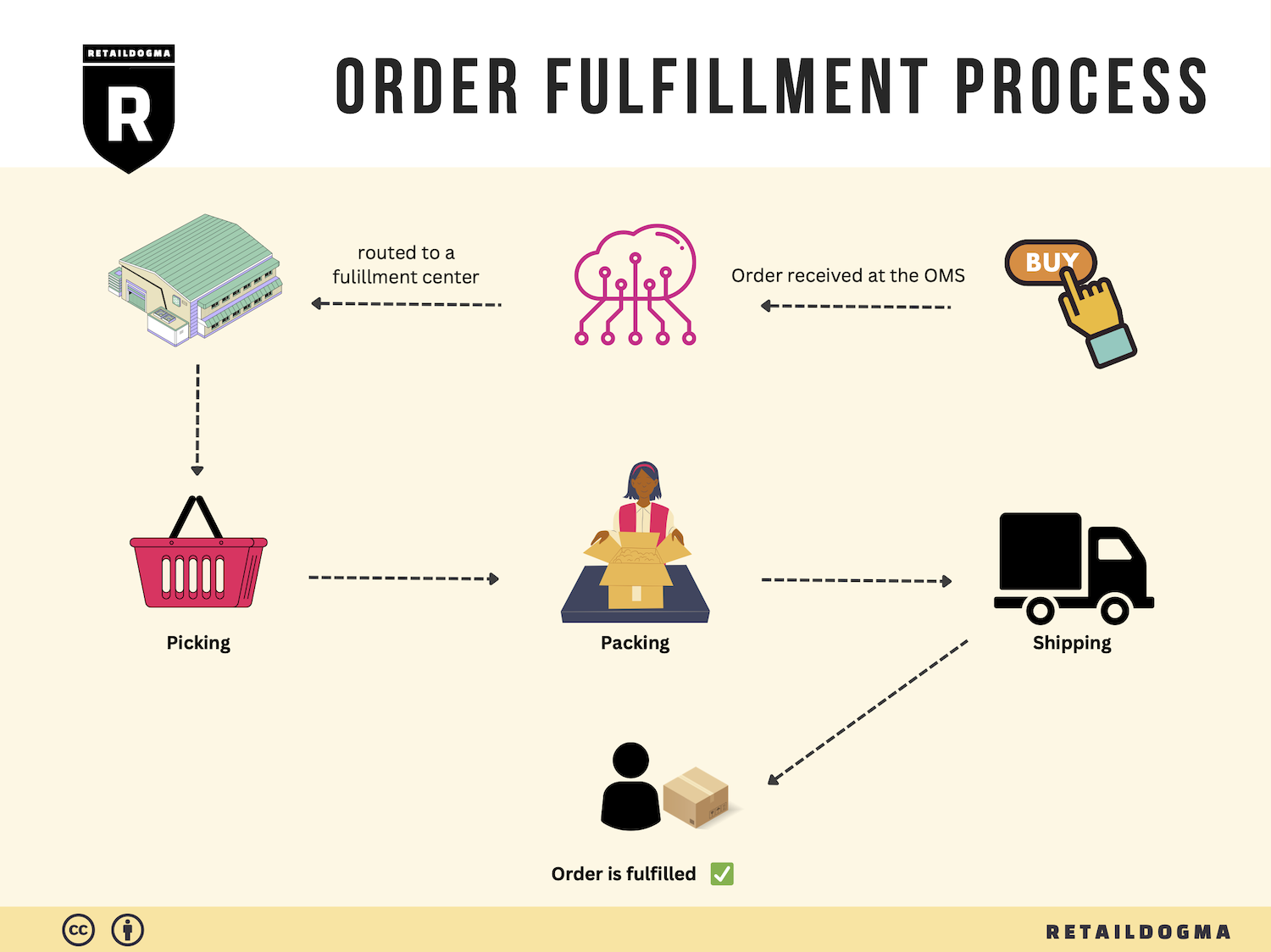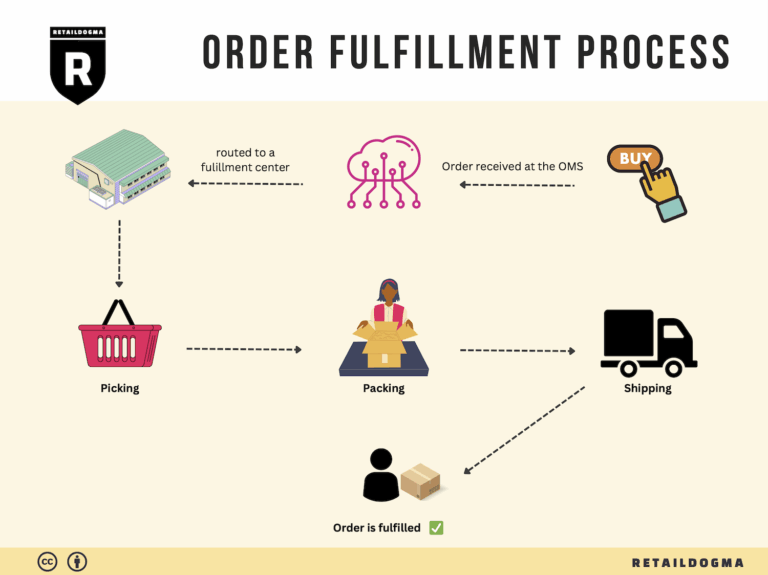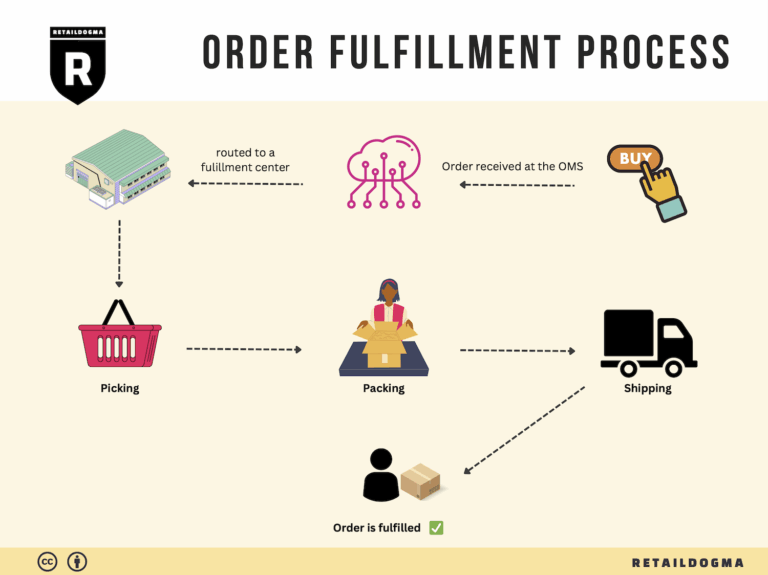How Order Fulfillment Works: A Step-by-Step Guide for Businesses
What is E-commerce Fulfillment? An Introduction for Growing Businesses
Understanding E-commerce Fulfillment
As an e-commerce business owner, you may find yourself grappling with the complexities of packing and shipping orders. The excitement of making sales can quickly turn into overwhelm when faced with the logistical challenges of fulfilling those orders efficiently. This is where e-commerce fulfillment comes into play. At its core, fulfillment is simply the process of getting a product from your inventory to your customer’s doorstep. It encompasses everything from receiving inventory to processing orders, packing items, and finally shipping them out.
Navigating the world of fulfillment can feel daunting, especially for growing businesses that are scaling their operations. This guide aims to demystify e-commerce fulfillment by breaking down the various models available, including Third-Party Logistics (3PL) and Fulfillment by Amazon (FBA), along with their respective benefits and challenges. Understanding these models is essential for making informed decisions about which approach aligns best with your business needs.
In addition to exploring fulfillment models, we will delve into the core services that fulfillment partners typically offer. These services can include inventory management, order processing, packaging, shipping, and returns management. Knowing what to expect can help you assess potential partners and ensure they align with your operational goals.
Choosing the right fulfillment partner is a critical decision that can significantly impact your business’s efficiency and customer satisfaction. This guide will provide you with practical criteria to consider when evaluating potential partners, such as their technology capabilities, shipping options, and customer service quality.
Lastly, we will address the often-overlooked aspect of pricing in fulfillment. Understanding the cost structures associated with different fulfillment services is crucial for maintaining your profit margins while delivering excellent service to your customers.
The ultimate goal of this guide is to empower you to make smart, strategic decisions about your logistics. By understanding the landscape of e-commerce fulfillment, you can streamline your operations, enhance customer experience, and scale your business with confidence. Whether you’re just starting out or looking to optimize your existing processes, this guide will serve as a valuable resource in your e-commerce journey.
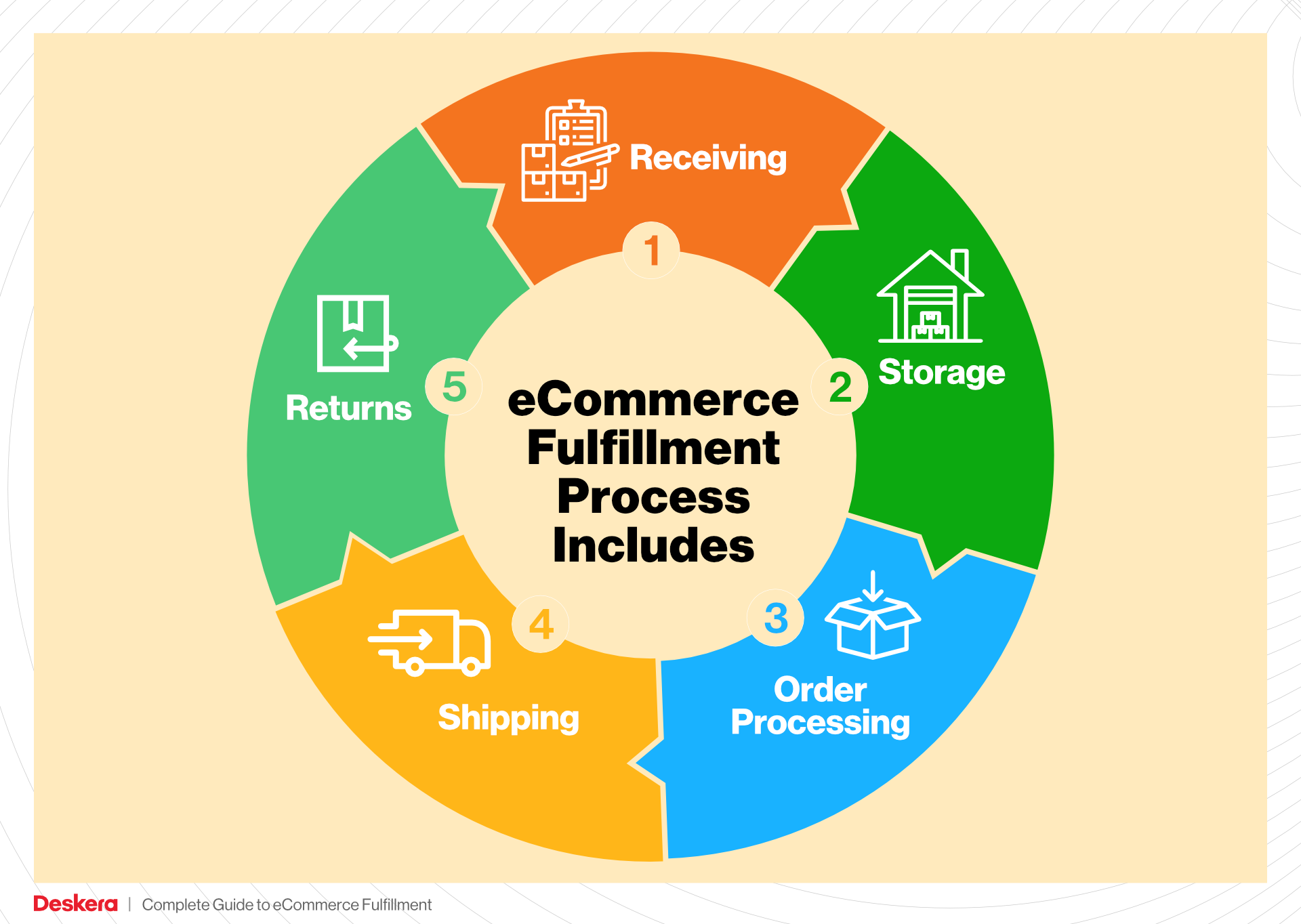
What You’ll Learn In This Guide
- What is E-commerce Fulfillment? An Introduction for Growing Businesses
- The Order Fulfillment Process: From ‘Buy’ Button to Customer’s Door
- Comparing Fulfillment Models: In-House vs. 3PL vs. Dropshipping
- A Deep Dive into Amazon FBA: Pros, Cons, and Who It’s For
- Core Services Offered by Fulfillment Centers
- How to Choose a Fulfillment Partner: A 6-Point Checklist
- Understanding Fulfillment Pricing: A Breakdown of Common Fees
- Frequently Asked Questions (FAQs) about Fulfillment
- Conclusion: Is Outsourcing Fulfillment the Right Move for Your Business?
- Important Disclaimer
The Order Fulfillment Process: From ‘Buy’ Button to Customer’s Door
1. Receiving Inventory
The first step in the order fulfillment process is receiving inventory, which involves accepting goods from suppliers and ensuring they match the purchase orders. This step is critical for maintaining accurate stock levels and ensuring that the right products are available for future orders. Upon arrival, each item is checked against its corresponding purchase order for discrepancies in quantity or quality.
A key term associated with this step is SKU (Stock Keeping Unit). Each product is assigned a unique SKU, which simplifies tracking and inventory management. Effective inventory receiving practices can reduce errors, prevent stockouts, and improve overall efficiency in the supply chain. Businesses should implement a systematic approach to receiving, including using barcode scanners for quick data entry and verification, thereby enhancing accuracy and speed.
2. Warehouse Storage
Once inventory is received, it needs to be stored efficiently in the warehouse. This step involves organizing products in a way that maximizes space and facilitates easy access for order fulfillment. Proper warehouse storage is essential for optimizing the picking process and minimizing the time it takes to retrieve items when orders come in.
The term warehouse layout is key here. An effective warehouse layout considers factors such as product popularity, size, and weight, which can influence how items are shelved. For example, frequently ordered items should be stored near the packing area to reduce retrieval time. Utilizing vertical space with shelving units and implementing a systematic labeling system can further enhance storage efficiency, ultimately leading to faster order processing times.
3. Order Picking
Order picking is the process of retrieving items from storage to fulfill customer orders. This step is crucial as it directly impacts order accuracy and customer satisfaction. Efficient picking practices can significantly reduce the time between when an order is placed and when it is shipped.
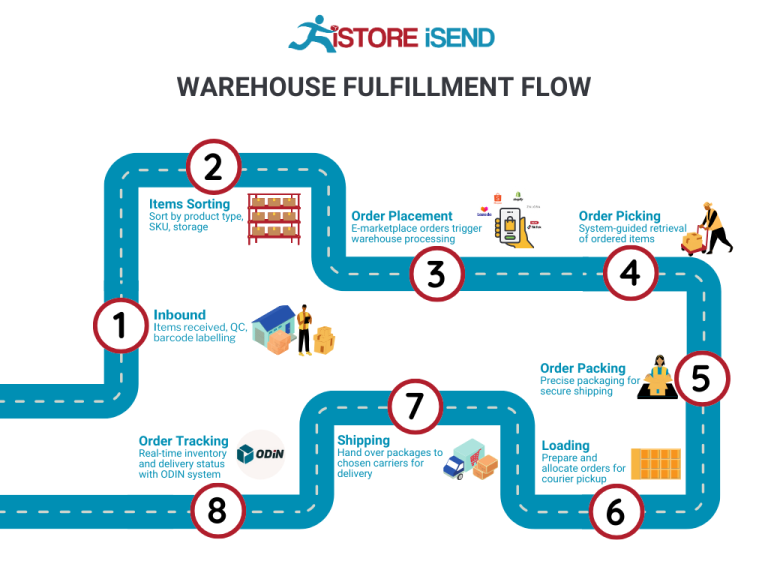
Pick lists are an essential tool in this phase. A pick list is a document or digital list that outlines the items needed to fulfill specific orders, including quantities and locations within the warehouse. Implementing picking methods, such as batch picking (picking multiple orders at once) or zone picking (assigning specific areas of the warehouse to individual pickers), can streamline the process and improve productivity. The accuracy of this step is vital, as errors can lead to returns and dissatisfied customers, which can negatively affect a business’s reputation and profitability.
4. Order Packing
After items are picked, they must be packed securely for shipping. This step is important for protecting products during transit and ensuring that they arrive at the customer’s location in good condition. Proper packing also affects shipping costs, as businesses need to balance the use of materials with the need to protect items.
Packing slips are an important component of this process. A packing slip is a document that accompanies the shipment and lists the items included in the package. This not only helps in verifying that the correct items are packed but also serves as a reference for the customer upon receipt. Businesses should consider using appropriate packing materials, such as bubble wrap or packing peanuts, to prevent damage during shipping. Additionally, implementing efficient packing stations with all necessary supplies can enhance productivity and reduce packing times.
5. Shipping & Delivery
The final step in the order fulfillment process is shipping and delivery. This step involves selecting the appropriate shipping method, labeling packages, and handing them over to carriers for delivery to customers. Timely and reliable shipping is crucial for maintaining customer satisfaction and fostering repeat business.
A key term in this phase is shipping carrier, which refers to the company responsible for transporting goods to customers. Businesses must evaluate various carriers based on factors such as delivery speed, cost, and reliability to choose the best option for their needs. Offering multiple shipping options can enhance customer experience, allowing them to choose what best suits their preferences. Additionally, tracking systems should be in place to provide customers with real-time updates on their orders, further improving transparency and trust in the fulfillment process.
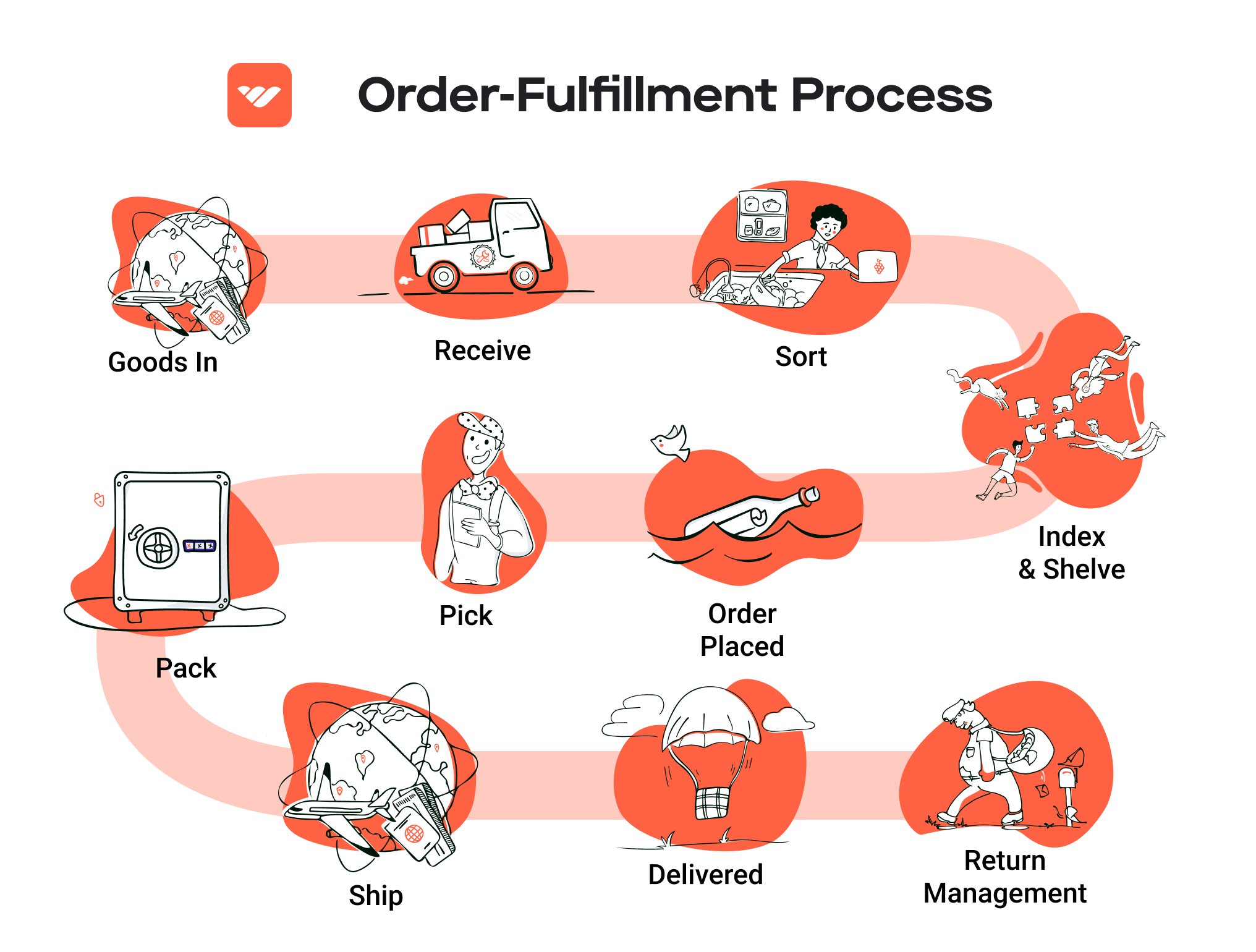
By understanding and optimizing each of these steps in the order fulfillment process, e-commerce businesses can enhance their operational efficiency, improve customer satisfaction, and ultimately drive growth.
Comparing Fulfillment Models: In-House vs. 3PL vs. Dropshipping
Fulfillment Model Comparison Table
| Model | Who Handles Inventory | Best For (Business Stage) | Key Advantage | Key Disadvantage |
|---|---|---|---|---|
| In-House Fulfillment | The e-commerce business itself | Established businesses with stable sales | Greater control over inventory and fulfillment processes | High upfront costs and operational complexity |
| Third-Party Logistics (3PL) | A third-party logistics provider | Growing businesses looking to scale | Reduced operational burden and access to expertise | Less control over the fulfillment process |
| Dropshipping | Supplier or manufacturer | Startups and small businesses | Low startup costs and minimal inventory risk | Lower profit margins and reliance on supplier reliability |
In-House Fulfillment
In-house fulfillment refers to the practice of managing the entire logistics process internally, from inventory management to order processing and shipping. This model is best suited for established businesses that have stable sales and the capacity to handle their logistics operations. One of the key advantages of in-house fulfillment is the level of control it provides. Businesses can oversee every aspect of the fulfillment process, ensuring that quality standards are met and that customer service is tailored to their specific needs. However, this model also comes with significant challenges. The initial investment can be substantial, requiring investments in warehousing, staff, and technology. Additionally, managing logistics can become operationally complex, diverting focus away from core business activities like marketing and product development.
Third-Party Logistics (3PL)
Third-party logistics (3PL) involves outsourcing the logistics and fulfillment operations to a specialized provider. This model is particularly advantageous for growing businesses that are looking to scale without the overhead associated with in-house fulfillment. By partnering with a 3PL, companies can benefit from the provider’s expertise, technology, and established infrastructure, which can lead to improved efficiency and reduced costs. 3PLs often have access to advanced logistics technologies that can enhance inventory management and order tracking. However, a key disadvantage of this model is the reduction in control over the fulfillment process. Businesses may find it challenging to maintain their brand’s quality standards and customer experience when relying on an external partner. Furthermore, communication issues or misalignment of goals between the business and the 3PL can lead to operational hiccups.
Dropshipping
Dropshipping is a fulfillment model where the retailer does not keep products in stock but instead transfers customer orders directly to the supplier or manufacturer, who then ships the products directly to the customer. This model is particularly appealing for startups and small businesses due to its low barrier to entry. With dropshipping, entrepreneurs can start an e-commerce business without the need for significant upfront investment in inventory, thus minimizing financial risk. Additionally, the model allows for a broad product range since retailers can offer products from multiple suppliers without holding stock. However, dropshipping does come with notable downsides. Profit margins can be lower compared to other fulfillment methods, as suppliers typically charge higher wholesale prices. Furthermore, businesses must rely heavily on the reliability and efficiency of their suppliers, as any issues on the supplier’s end—such as stock shortages or shipping delays—can negatively impact the retailer’s reputation and customer satisfaction.
Conclusion
Choosing the right fulfillment model is critical for the success of an e-commerce business. Each model—whether in-house fulfillment, third-party logistics, or dropshipping—offers unique advantages and disadvantages that must be carefully considered in the context of the company’s goals, operational capabilities, and stage of growth. Understanding these factors can empower business owners to make informed decisions that align with their strategic objectives and ultimately drive their success in the competitive e-commerce landscape.
A Deep Dive into Amazon FBA: Pros, Cons, and Who It’s For
Understanding Fulfillment by Amazon (FBA)
Fulfillment by Amazon (FBA) is a service provided by Amazon that allows sellers to store their products in Amazon’s fulfillment centers. When a customer places an order, Amazon takes care of storage, packaging, and shipping of the products. This service enables e-commerce businesses to leverage Amazon’s extensive logistics network and customer service capabilities, allowing sellers to focus on growing their business rather than managing logistics.
How FBA Works
-
Setup and Registration: Sellers need to create an Amazon Seller account and choose FBA as their fulfillment method. This involves setting up a product listing and preparing inventory for shipment to Amazon’s warehouses.
-
Shipping Inventory: Sellers ship their products to Amazon’s fulfillment centers. Amazon provides guidelines on how to package and label items for efficient processing.
-
Storage: Once received, products are stored in Amazon’s warehouses until sold. Amazon manages the inventory and keeps track of stock levels.
-
Order Processing: When a customer orders a product, Amazon picks, packs, and ships the item on behalf of the seller. The seller benefits from Amazon’s fast shipping options, including Prime.
-
Customer Service and Returns: Amazon handles customer inquiries and returns, providing a seamless experience for buyers and reducing the workload for sellers.
Pros of Using FBA
1. Prime Eligibility
Products fulfilled by Amazon are eligible for Amazon Prime, which offers customers free two-day shipping. This can significantly increase a seller’s visibility and sales, as Prime members are more likely to purchase items that come with this benefit. Being part of the Prime program enhances customer trust and loyalty, driving repeat purchases.
2. Customer Trust and Credibility
Using FBA enhances credibility as customers often trust Amazon’s fulfillment services. Amazon’s established reputation for reliable shipping and excellent customer service can lead to higher conversion rates, as customers feel more secure purchasing from sellers who use FBA.
3. Multi-Channel Fulfillment
FBA allows sellers to fulfill orders from multiple sales channels (e.g., eBay, Shopify) using Amazon’s infrastructure. This multi-channel fulfillment capability simplifies logistics for businesses that sell across various platforms, allowing them to centralize their inventory and streamline their operations.
4. Simplified Logistics
FBA reduces the complexity of logistics management. Sellers do not need to handle storage, packing, or shipping, which can be particularly beneficial for small businesses or those new to e-commerce. Amazon’s sophisticated logistics network ensures timely delivery and inventory management.
5. Scalability
FBA offers scalability for businesses. As demand increases, sellers can easily send more inventory to Amazon’s fulfillment centers without worrying about expanding their own storage or logistics capabilities. This flexibility allows sellers to grow their business without being bogged down by logistical challenges.
Cons of Using FBA
1. High Fees
While FBA provides numerous benefits, it comes with costs that can add up quickly. Sellers must pay storage fees based on the volume of inventory stored and fulfillment fees for each order processed. These fees can significantly impact profit margins, especially for low-cost items.
2. Strict Inventory Rules
Amazon has specific inventory management rules that sellers must adhere to. This includes restrictions on the types of products that can be stored and sold, as well as guidelines for labeling and packaging. Sellers who do not comply may face penalties, including removal of their inventory.
3. Commingling Risks
FBA operates on a commingling model where inventory from different sellers is stored together. This can lead to issues if a seller’s inventory is mixed with defective or counterfeit products. If a customer receives the wrong product or a damaged item, it can reflect poorly on the seller, even if they are not at fault.
4. Loss of Control
Using FBA means relinquishing control over certain aspects of the fulfillment process. Sellers have limited visibility into the handling and shipping of their products, which can lead to challenges in maintaining brand consistency and customer experience.
5. Competition
Sellers using FBA may find themselves in a highly competitive environment. Many sellers use FBA, which can lead to price wars and reduced margins. It is crucial for sellers to differentiate their products to stand out in a crowded marketplace.
Who is FBA Best For?
FBA is particularly well-suited for:
- Small to Medium-Sized Businesses: Companies that lack the resources to manage logistics can benefit from Amazon’s established network.
- E-commerce Entrepreneurs: Those starting their online business who want to leverage Amazon’s credibility and customer base without investing heavily in logistics.
- High-Volume Sellers: Businesses that sell a large volume of products can capitalize on the efficiencies of FBA to scale operations effectively.
- Brands Seeking Prime Visibility: Sellers who want to tap into Amazon Prime’s customer base and enhance their product visibility should consider FBA.
In conclusion, while FBA offers significant advantages such as Prime eligibility, increased customer trust, and simplified logistics, it is essential for sellers to weigh these benefits against the associated costs and risks. Understanding these factors can help e-commerce businesses make informed decisions about whether FBA aligns with their operational goals and growth strategies.
Core Services Offered by Fulfillment Centers
Inventory Management & Warehousing
Inventory management and warehousing are foundational services provided by fulfillment centers that enable e-commerce businesses to maintain control over their stock levels. This service involves the systematic tracking of inventory from the moment it arrives at the fulfillment center until it is shipped out to customers.
What It Is: Fulfillment centers utilize advanced inventory management software to monitor stock levels, manage reordering processes, and provide real-time visibility into inventory status. This includes categorizing products, tracking expiration dates for perishable goods, and ensuring that inventory is organized for efficient access.
Benefits: Effective inventory management minimizes the risk of stockouts or overstock situations, both of which can significantly impact sales and customer satisfaction. By outsourcing this function, e-commerce businesses can free up resources and focus on core activities like marketing and product development. Moreover, accurate inventory data helps in making informed decisions, optimizing stock levels, and reducing carrying costs, ultimately leading to improved cash flow.
Pick and Pack Services
Pick and pack services are essential for streamlining the order fulfillment process. This involves selecting items from inventory, packing them securely, and preparing them for shipment.
What It Is: When a customer places an order, the fulfillment center’s staff picks the ordered items from the warehouse shelves. Each item is then packed according to specific guidelines, which may include protective packaging, branded materials, or specific box sizes. This process can be highly automated with the use of robotics and barcode scanning technology.
Benefits: Efficient pick and pack services reduce order processing times, which is critical for maintaining high customer satisfaction levels. Quick turnaround times can enhance a brand’s reputation and encourage repeat business. Additionally, expert packers ensure that products are shipped safely, reducing the likelihood of damage during transit and minimizing return rates. By outsourcing this service, e-commerce businesses can scale their operations without the need for significant investment in labor or infrastructure.
Kitting and Assembly
Kitting and assembly services involve the pre-packaging of multiple products into a single unit before shipment. This is particularly beneficial for products that are sold together or require assembly.
What It Is: In a kitting process, individual items are grouped together and packaged as a single kit. For example, a company selling a DIY furniture set may require assembly of various components into a kit that includes all necessary parts and instructions. This service can also extend to product assembly, where items are put together before they are shipped.
Benefits: Kitting can enhance the customer experience by providing a complete solution in one package, which can simplify the purchasing process. It also allows businesses to create bundled offers, which can increase average order value. Furthermore, kitting reduces the time customers spend on assembly, leading to higher satisfaction. By outsourcing these tasks, e-commerce businesses can streamline their operations and reduce the complexity of logistics management.
Returns Management (Reverse Logistics)
Returns management, or reverse logistics, is a critical service offered by fulfillment centers that deals with the processing of returned goods.
What It Is: This service encompasses all activities related to the return of products from customers back to the fulfillment center. It includes receiving returned items, inspecting them for damage, restocking them if they are in sellable condition, and processing refunds or exchanges.
Benefits: An efficient returns management system is vital for maintaining customer trust and satisfaction. A seamless return process can enhance brand loyalty, as customers are more likely to repurchase from a business that handles returns effectively. Additionally, effective reverse logistics can help businesses recover value from returned items, whether by restocking, refurbishing, or recycling. By outsourcing this complex process, e-commerce businesses can minimize operational burdens and improve their overall customer service experience.
Conclusion
In conclusion, fulfillment centers provide a suite of core services that are essential for the efficient operation of e-commerce businesses. From inventory management and warehousing to pick and pack services, kitting and assembly, and returns management, these services not only streamline logistics but also enhance customer satisfaction and operational efficiency. By leveraging the expertise and resources of fulfillment centers, e-commerce businesses can focus on growth and scaling their operations effectively.
How to Choose a Fulfillment Partner: A 6-Point Checklist
Location & Warehouse Network
Choosing the right fulfillment partner begins with understanding their location and warehouse network. The proximity of a fulfillment center to your customer base can significantly impact shipping times and costs.
Why It Matters:
– Faster delivery times can enhance customer satisfaction and retention.
– Reduced shipping costs can improve your overall profit margins.
Questions to Ask:
– Where are your warehouses located, and how does that align with my target market?
– What is your average shipping time to various regions?
– Do you have a strategy for managing shipping costs across different locations?
Technology & Integrations
In today’s digital landscape, a fulfillment partner’s technological capabilities are paramount. The ability to integrate seamlessly with your existing systems (like your e-commerce platform, inventory management software, and CRM) can streamline operations.
Why It Matters:
– Efficient data flow between systems reduces errors and enhances inventory management.
– Real-time tracking and reporting can improve decision-making.
Questions to Ask:
– What technologies do you use for inventory management and order processing?
– Can you integrate with my existing e-commerce platform and other software?
– Do you provide real-time tracking for shipments, and how is this communicated to customers?
Specializations (e.g., Cold Storage, Oversized Items)
Different businesses have unique fulfillment needs. If your products require special handling—such as cold storage for perishables or extra space for oversized items—it’s crucial to find a partner with the right capabilities.
Why It Matters:
– Specialized storage ensures product integrity and compliance with regulations.
– Tailored fulfillment processes can enhance operational efficiency.
Questions to Ask:
– Do you have the facilities to handle my specific product types (e.g., temperature-sensitive items, oversized goods)?
– What certifications or standards do you comply with for specialized storage?
– How do you manage inventory for products with specific handling requirements?
Scalability & Capacity
As your business grows, your fulfillment needs will evolve. A partner should be able to scale with you, whether that means handling more orders during peak seasons or accommodating new product lines.
Why It Matters:
– Flexibility can prevent bottlenecks in your supply chain and ensure you can meet customer demand.
– A partner that can scale reduces the need for frequent changes in your logistics strategy.
Questions to Ask:
– How do you handle fluctuations in order volume?
– What is your current capacity, and how quickly can you scale up if needed?
– Can you accommodate seasonal spikes in demand, and what strategies do you employ to manage this?
Pricing and Contracts
Understanding the pricing structure and contract terms of a fulfillment partner is crucial to avoid hidden costs and ensure alignment with your budget.
Why It Matters:
– Transparent pricing helps you maintain control over your operational costs.
– Clear contract terms can prevent misunderstandings and ensure accountability.
Questions to Ask:
– Can you provide a detailed breakdown of your pricing structure (e.g., storage fees, shipping costs, pick and pack fees)?
– Are there any additional fees I should be aware of (e.g., for returns, inventory management)?
– What are the contract terms, and what is the process for renegotiation or termination?
Customer Support & Reviews
The level of customer support a fulfillment partner offers can significantly impact your operations. Additionally, looking at reviews and testimonials can provide insight into their reliability and service quality.
Why It Matters:
– Responsive customer support can resolve issues quickly, minimizing disruptions.
– Positive reviews can indicate a partner’s commitment to customer satisfaction and operational excellence.
Questions to Ask:
– What support channels do you offer (e.g., phone, email, live chat), and what are your response times?
– Can you provide references or case studies from similar businesses in my industry?
– How do you handle issues such as order discrepancies or shipping errors, and what is your process for resolution?
Conclusion
Choosing the right fulfillment partner is a pivotal decision for any e-commerce business. By using this checklist, you can methodically evaluate potential partners based on critical factors such as location, technology, specialization, scalability, pricing, and customer support. Thoroughly assessing these areas will not only help you find a partner that meets your current needs but also one that can grow with your business and contribute to its long-term success.
Understanding Fulfillment Pricing: A Breakdown of Common Fees
Initial Setup Fees
When partnering with a fulfillment center, one of the first costs you may encounter is the initial setup fee. This fee typically covers the administrative and technical work required to integrate your systems with the fulfillment provider. Depending on the complexity of your operations, this can range from a few hundred to several thousand dollars.
The setup process often includes creating your product listings, configuring inventory management systems, and establishing order processing protocols. Some fulfillment centers may waive this fee if you commit to a long-term contract or if your initial order volume meets a certain threshold. To minimize these costs, ensure you have all necessary information and documentation ready to streamline the setup process.
Receiving Fees
Receiving fees are charged when the fulfillment center takes delivery of your inventory. This fee generally covers the labor involved in unloading shipments, inspecting items for damage, and entering them into inventory management systems.
The calculation of receiving fees can vary significantly from one provider to another. Some charge a flat fee per shipment, while others may charge based on the number of pallets or the total weight of the goods received. To manage these costs effectively, consider scheduling shipments in bulk and ensuring that they are well-organized and clearly labeled to facilitate faster processing.
Storage Fees (per pallet/bin)
Storage fees are incurred for the space your inventory occupies within the fulfillment center. These fees can be calculated in different ways, often based on the volume of space used, such as per pallet or per bin. Most fulfillment centers will charge a monthly fee, which can vary based on the time of year, with higher rates during peak seasons like the holidays.
It’s essential to monitor your inventory turnover rates to avoid excessive storage fees. Consider employing a just-in-time inventory strategy to minimize the amount of stock stored at the fulfillment center. Additionally, negotiating storage fees based on your projected inventory levels can lead to significant savings.
Pick & Pack Fees (per item/order)
Pick and pack fees are charged each time an order is processed. This fee covers the labor required to locate items in the warehouse (picking) and package them for shipment (packing). The pricing structure for pick and pack fees can vary; some fulfillment centers charge a flat fee per order, while others charge based on the number of items in each order.
To keep these costs in check, consider optimizing your product offerings and order sizes. Encouraging customers to purchase multiple items in a single order can reduce the number of pick and pack fees incurred. Additionally, look for fulfillment partners that offer tiered pricing based on order volume, as this can provide cost savings as your business scales.
Shipping Fees
Shipping fees represent one of the most significant costs in the fulfillment process and can vary widely based on factors such as package weight, dimensions, destination, and the shipping method chosen (standard, expedited, etc.). Many fulfillment centers have partnerships with major carriers and can offer discounted shipping rates, which can help lower your overall costs.
To effectively manage shipping fees, it’s crucial to analyze your shipping options regularly. Consider using software that can compare rates across multiple carriers to find the best prices. Additionally, you might explore options for negotiated rates with carriers based on your shipping volume, which can yield substantial savings.
Conclusion: Tips for Accurate Quotes
When seeking quotes from fulfillment centers, transparency is key. Here are some practical tips to ensure you receive accurate and comprehensive quotes:
-
Provide Detailed Information: Clearly outline your product types, anticipated order volumes, and any special handling requirements. This will help fulfillment centers provide precise estimates.
-
Ask for Breakdown of Fees: Request a detailed breakdown of all potential fees, including setup, receiving, storage, pick and pack, and shipping fees. This will give you a clearer picture of the total costs involved.
-
Negotiate Terms: Don’t hesitate to negotiate pricing and terms, especially if you expect to scale your operations. Many fulfillment centers are open to adjusting fees based on long-term commitments or higher volume guarantees.
-
Review Contracts Carefully: Before signing any agreements, review the terms to ensure there are no hidden fees or unfavorable clauses that could impact your profitability.
-
Consider Seasonal Variations: Be aware that fulfillment costs may fluctuate during peak seasons, so factor this into your budgeting and forecasting.
By understanding these common fulfillment pricing models and following these tips, you can make informed decisions that align with your business goals while effectively managing costs.
Frequently Asked Questions (FAQs) about Fulfillment
1. What is the fulfillment triangle meme, and how does it relate to e-commerce?
The fulfillment triangle meme illustrates the complex relationship between three critical aspects of fulfillment: cost, speed, and quality. In e-commerce, businesses often face trade-offs among these elements. For example, to achieve faster shipping, a company may need to increase costs, potentially sacrificing quality. Understanding this triangle helps e-commerce businesses balance their operational strategies effectively.
2. What’s the difference between a warehouse and a fulfillment center?
A warehouse is primarily used for storage, focusing on inventory management and long-term storage solutions. In contrast, a fulfillment center is designed for order processing and shipping, emphasizing rapid order fulfillment and distribution. Fulfillment centers often include value-added services like packaging and returns processing, making them essential for e-commerce businesses.
3. What is a 3PL, and how can it benefit my e-commerce business?
A Third-Party Logistics (3PL) provider manages logistics and fulfillment tasks for businesses. This can include warehousing, inventory management, and shipping. Partnering with a 3PL allows e-commerce businesses to scale operations, reduce overhead costs, and leverage the provider’s expertise in logistics, which can enhance overall efficiency and customer satisfaction.
4. How much do fulfillment services cost?
The cost of fulfillment services varies widely based on factors such as order volume, storage needs, shipping methods, and specific service requirements. Generally, costs can range from a few dollars per order to a percentage of sales. It’s essential to evaluate multiple providers and understand their pricing structures to find the best fit for your business.
5. How can I improve the efficiency of my fulfillment process?
Improving fulfillment efficiency can be achieved by optimizing inventory management, leveraging technology (like warehouse management systems), and streamlining order processing workflows. Additionally, regularly analyzing performance metrics can identify bottlenecks and areas for improvement, allowing you to enhance overall operational efficiency.
6. What role does technology play in modern fulfillment operations?
Technology plays a crucial role in modern fulfillment operations by automating processes, improving accuracy, and providing real-time data analytics. Solutions like inventory management software, order tracking systems, and automated picking systems can significantly enhance efficiency, reduce errors, and improve customer satisfaction.
7. What are the key metrics to track in fulfillment?
Key metrics to track in fulfillment include order accuracy rate, order cycle time, inventory turnover, shipping costs, and customer satisfaction scores. Monitoring these metrics helps businesses identify performance trends, optimize operations, and enhance the overall customer experience.
8. How can I handle returns effectively in my fulfillment process?
To handle returns effectively, establish a clear returns policy and streamline the returns process. Utilizing a returns management system can automate the tracking and processing of returns, making it easier to restock items and communicate with customers. Additionally, analyzing return data can help identify patterns and improve product offerings.
9. What are the benefits of using a fulfillment service?
Using a fulfillment service can provide several benefits, including reduced operational costs, access to advanced logistics technology, improved order accuracy, and faster shipping times. It allows e-commerce businesses to focus on core activities like marketing and product development while experts handle logistics.
10. How do I choose the right fulfillment partner for my business?
When choosing a fulfillment partner, consider factors such as their experience in your industry, technology capabilities, scalability, customer service, and pricing structure. Additionally, it’s important to evaluate their fulfillment speed and reliability through customer reviews and case studies to ensure they align with your business needs and growth plans.
Conclusion: Is Outsourcing Fulfillment the Right Move for Your Business?
Evaluating the Benefits of Outsourcing Fulfillment
Outsourcing fulfillment can offer significant advantages for e-commerce businesses aiming to scale efficiently. One of the primary benefits is time savings. By delegating order processing, inventory management, and shipping logistics to a dedicated fulfillment partner, you can free up valuable resources. This allows you and your team to focus on core business activities such as marketing, product development, and customer engagement, ultimately driving growth.
Additionally, partnering with a fulfillment service enables scalability. As your business grows, so do the demands of your logistics. A proficient fulfillment partner has the infrastructure and technology to handle fluctuations in order volume, seasonal peaks, and expanding product lines without the need for your direct involvement. This adaptability can be crucial for maintaining service levels and customer satisfaction as you scale.
Furthermore, fulfillment services bring expertise to the table. These providers are specialized in logistics and shipping, often equipped with the latest technology and industry best practices. This can translate to improved shipping rates, faster delivery times, and enhanced inventory management strategies, all of which can lead to a better overall customer experience.
However, it’s essential to emphasize the importance of choosing the right partner. Not all fulfillment services are created equal; aligning with a provider that understands your business model, customer expectations, and growth objectives is critical for long-term success.
Call to Action
As you consider the next steps in your e-commerce journey, take a moment to audit your current shipping process. Evaluate your order fulfillment efficiency, costs, and customer feedback. This assessment will help you determine whether partnering with a fulfillment service is the right move for your business and set the stage for sustainable growth.
Important Disclaimer
⚠️ Important Disclaimer
The information in this guide is for educational purposes. Fulfillment services, pricing, and platform features change frequently. Always conduct your own due diligence and consult with providers directly before making business decisions.
